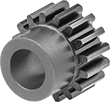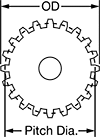About Gears
More
Metal Gears and Gear Racks—14 1/2° Pressure Angle
A former industry standard, 14½° pressure angle gears are often found on older machinery. Made of carbon steel, they have high strength and are better than plastic gears and gear racks for high-load, high-speed, and heavy duty applications.
Combine gears with different numbers of teeth to change speed and torque in your assembly. Combine a gear and rack to convert rotary motion into linear motion.
For components to mesh correctly, they must have the same pressure angle and pitch.
Gears with machinable bore have a large hub diameter so you can machine them to fit your shaft.
Gears with teeth that are not hardened can be hardened to fit your application. Hardening a gear's teeth increases its wear resistance.


Hub | ||||||||||||
|---|---|---|---|---|---|---|---|---|---|---|---|---|
| Gear Pitch | Number of Teeth | Gear Pitch Dia. | OD | Face Wd. | Overall Wd. | For Shaft Dia. | Material | Teeth Heat Treatment | Dia. | Wd. | Each | |
Round/Machinable Bore | ||||||||||||
| 6 | 30 | 5" | 5.33" | 1 1/2" | 2.5" | 1 1/8"-2" | 1144 Carbon Steel | Not Hardened | 3.125" | 1" | 0000000 | 0000000 |

























